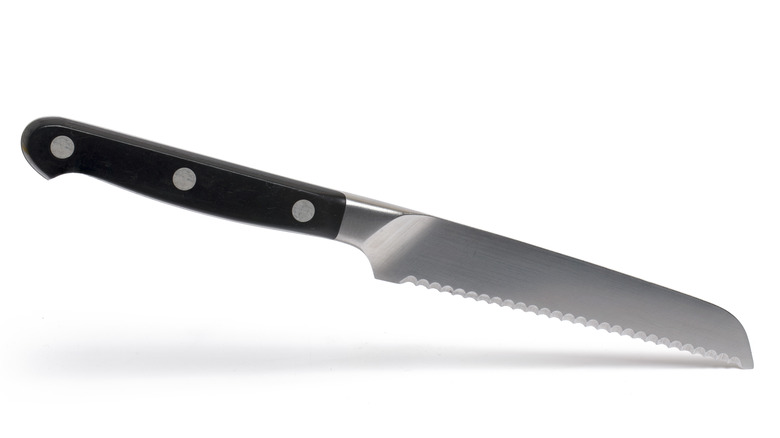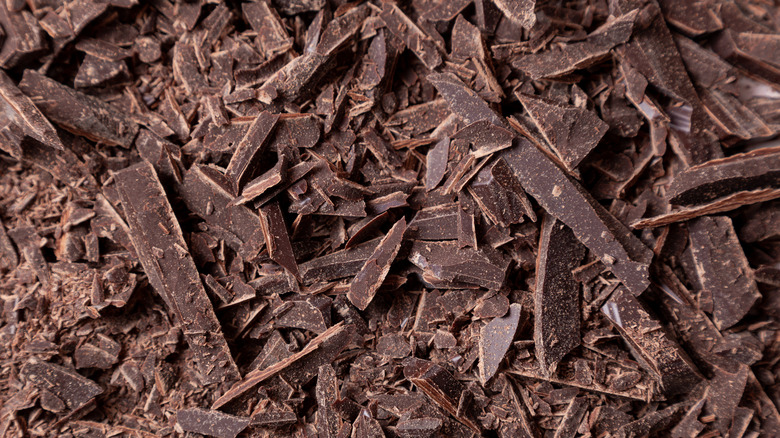Giada De Laurentiis' Knife Tip To Easily Chop Chocolate Bars
Food personality Giada De Laurentiis is letting her fans in on a professional secret. Instead of a chef's knife, food processor, or rolling pin, she uses a serrated blade to easily and quickly break down chocolate bars. It's about time the tool, one of the only three knives you need in your kitchen, gets its due.
Though it often gets referred to as a bread knife, a serrated blade is just as helpful piercing finicky hunks of cocoa. De Laurentiis uses the tool when making cookies, ensuring plenty of melty chunks dot her oatmeal cranberry cookies. She's not the only one — this tip is a favorite of pastry chefs, who use the same trick to go through tons of the ingredient.
@giadadelaurentiis Chocolate chunk, oatmeal, cranberry cookies!! #HolidaysOurWay
A quick chop, and you'll have a pile of the chocolate to melt down and temper, fold into brownie batter, or sprinkle into dough. Though De Laurentiis used her serrated knife on a bittersweet bar, the tool works on other types and shapes, like white chocolate and massive blocks of baking chocolate, too. The added control of the under-used and very sharp blade means you can make the shavings as large or small as you'd like, so you can adjust the bits to your bake.
Use a serrated knife on chocolate
Serrated knives have already staked their claim on bread, tomatoes, and are even considered the best knife for cutting watermelon. It's become a go-to for anything with tough skin and a soft center. But why is it better to chop a hard chocolate bar with the blade? Its teeth allow it to glide through the flaky ingredient with little resistance, rather than glance off like a chef's knife does.
You'll find the cuts produce similar-sized pieces ready to fold and melt into batters. To get the best results, keep your slices thin and cut the bar at a diagonal, starting at one corner and working your way across. Unlike with bread, you'll find a firm press or gentle rocking of the knife will coax it through — no need to hack, saw, or wiggle the knife to get it to slice.
The best part is the slices stay neatly in place after each pass through the bar, rather than flying across your cutting board. Though it's still a little challenging to push the pile into your mixing bowl, it's a whole lot easier than herding the wispy bits that result from a straight-edged blade. If the shavings are still causing frustration, you can try ever-so-slightly warming (not melting!) the bar for just a few seconds in the microwave to keep it stuck together and pliable.
Benefits of choosing bars over chips
Chocolate chips will always have a place in our pantry, but there are benefits to using a chopped bar. Morsels are made with additives that help them keep their shape as they bake, which allows them to neatly dot chocolate chip cookies. Bars are designed for a completely different purpose: to melt and coat your mouth. They're usually higher quality than the bags on the baking aisle — though they can cost more, too.
The uneven shards, along with any scrapings and flakes, allow for it to penetrate more of the batter and melt into delicious goo. And although there are a variety of chips available at the store, you'll have more options for brands and types of chocolate if you use bars. Plus, if you're hoping to use up the last of your sweet white chocolate and bitter dark chocolate, you can easily chop and combine the two.
You'll find taking the time to chop chocolate using chef Giada De Laurentiis' tip may ultimately speed up other parts of your baking process since small pieces will melt faster. Since you can shave off large bites, you make an especially loaded batter capable of satisfying the biggest sweet tooth. Best of all, the blended flakes can actually produce a chewier, more supple cookie.



